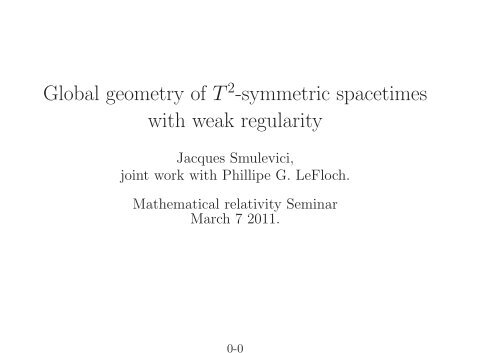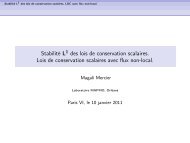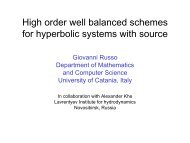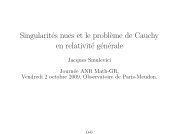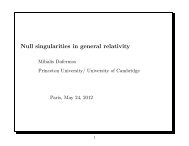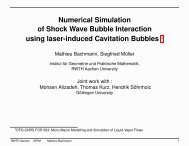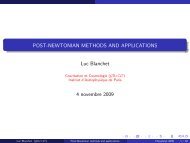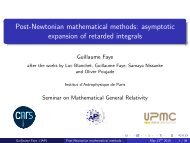Weakly regular T2 symmetric spacetimes - Philippe LeFloch
Weakly regular T2 symmetric spacetimes - Philippe LeFloch
Weakly regular T2 symmetric spacetimes - Philippe LeFloch
You also want an ePaper? Increase the reach of your titles
YUMPU automatically turns print PDFs into web optimized ePapers that Google loves.
• Aim: study the global Cauchy problem in relativity, i.e.asymptotics and global properties of solutions to the initialvalue problem for the (vacuum) Einstein equations:• within symmetry classes,• under low <strong>regular</strong>ity assumptions.R µν = Λg µν . (1)1
Overview of the main results:• We introduce a class of <strong>symmetric</strong> solutions (T 2 -<strong>symmetric</strong>)with <strong>regular</strong>ity assumptions such that the equations reduce asystem of 1 + 1 quasi-linear wave equations with data in a“natural” energy space.• We prove the existence of a weak formulation of the Einsteincontraint and Einstein evolution equations in this class.• We prove a global existence theorem with respect to ageometrically defined time function for this class.• We derive asymptotics of the solutions (in the expandingdirection) under additional assumptions.2
Cauchy Problem in relativityRecall: an initial data set for the (vacuum) Einstein equations is atriple (Σ, h, K) such that:• (Σ, h) is a complete Riemannian 3-manifold,• K is a <strong>symmetric</strong> 2-tensor,• (Σ, h, K) satisfy the constraint equations of general relativity.A development of (Σ, h, K) is a 3 + 1 Lorentzian manifold (M, g)satisfying the Einstein equations with an embedding φ : Σ → Msuch that the pull-back of the first and second fundamental formsof φ(Σ) coincides with (h, K).3
Local theory without symmetryTheorem 1 (Choquet-Bruhat and Geroch). To any smooth initialdata set, one can associate a unique (up to diffeomorphism)maximal globally hyperbolic development.Local existence theory :• First result by Choquet-Bruhat, (h, K) ∈ H s × H s−1 , s large.• Hughes-Kato-Marsden (energy method): s > 5/2• Strichartz: Bahouri-Chemin, Tataru (s > 2 + 1/6)• Best current result: Klainerman-Rodnianski, (Smith-Tataru):s > 2• L 2 -curvature conjecture• Geometric uniqueness for s > 5/2: Planchon-Rodnianski• Low <strong>regular</strong>ity initial data: Choquet-Bruhat s > 5/2, Maxwells > 3/24
Smooth T 2 -<strong>symmetric</strong> initial data:• Σ diffeomorphic to T 3 ,• Effective action of T 2 leaving invariant (h, K).• two independent commuting Killing fields: X, Y .5
More symmetry• Gowdy case: integrability of the 2-planes orthogonal to X, Y .• Twists quantities:C Y = ǫ abcd X a Y b ∇ c Y dC X = ǫ abcd X a Y b ∇ c X d• For smooth solutions, vacuum Einstein equations implies thattwists are constant.• Gowdy: C X = C Y = 0.6
Gauge conditionsOne challenge in the study of the Cauchy problem for the Einsteinequations consists in finding a good “gauge” in which theformulation for the Einstein equations simplifies as much aspossible.7
Local geometry of T 2 -<strong>symmetric</strong> solutionsTheorem 2 (Chruściel). Let (M, g) be the maximal Cauchydevelopment of C ∞ T 2 -<strong>symmetric</strong> data, with Λ = 0.• Assume (M, g) is non-flat,• Let R be the area element of the orbits of symmetry:R 2 = g(X, X)g(Y, Y ) − g(X, Y ) 2 .Then ∇R is timelike.Extension of this result to local U(1) × U(1) symmetry, reasonablematter models (including Vlasov matter) and Λ > 0: Rendall.8
Classical result for smooth initial data: Global arealfoliations of T 2 -<strong>symmetric</strong> solutionsTheorem 3 (Berger-Isenberg-Chrusciel-Moncrief). Let (M, g) bethe maximal Cauchy development of smooth non-flat T 2 -<strong>symmetric</strong>initial data with Λ = 0.Then (M, g) admits a global foliation by the level sets of R, each ofthem being a Cauchy surface, and such that R ∈ (R 0 , ∞), for someR 0 ≥ 0.Time direction where R increases: expanding or future direction.Time direction where R decreases: contracting or past direction.(The above theorem is a global existence result in areal coordinatesto the future, local existence result to the past.)Extenstion to Λ > 0: Isenberg-Clausen. Extension to Vlasovmatter: Andreasson, Rendall, Weaver. Previous work for Gowdy:Moncrief, Andreasson (Vlasov matter),9
Past global existence ?Global existence in areal coordinates to the past: R 0 = 0.• Λ = 0: Isenberg-Weaver.• Λ > 0, under a genericity criterion, J.S. (2008)Key points for the Λ > 0 case:• existence of non-global solutions, need to capture theirinstability,• key points of the proof include: a new blow up criterion forT 2 -<strong>symmetric</strong> <strong>spacetimes</strong>, identification of a hierarchy in theequations, analysis of the geometry of characteristics, refinednull cone estimates10
Structure of the equations in areal coordinates IReduction of the equations on M/T 2 :Let Q = M/T 2 .Topology: Q ∼ R × S 1 .Q inherits a Lorentzian metric from (M, g) and all metric functionsdescends to functions on Q.Conformal metric:g Q = −Ω 2 (dR 2 − a −2 dθ 2 )˜g Q = −dR 2 + a −2 dθ 2“a” should be thought of as the “lapse”.11
Structure of the equations in areal coordinates IIR µν = 0 then reduces to equations for 4 functions on Q: a, Ω, U, A(U and A are related to the lengths and the angles of X and Y )⎧⎨⎩⎧⎨⎩□˜g U = q(∂U, ∂A) + l(∂U)□˜g A = q(∂U, ∂A) + l(∂A)coupled to :first order equations (including the constraints)for ∂a, ∂Ω, ∂U, ∂Aq is quadratic in ∂g, l is linear in ∂g.Quasi-linear wave equations in 1 + 1 dimensions.12
Structure of the equations in areal coordinates III: thewave equations for U and A• 1+1 wave map equations from (Q, ˜g Q ) to H 2 + lower orderterms.• But ˜g Q depends on the solution! Hence, quasilinear equations• Nonetheless q satisfies the null condition (cf. Klainerman,Christodoulou) i.e. there exists a null frame L,¯L such thatschematically:q = gL(g)¯L(g).13
Structure of the equations in areal coordinates IV: the 1storder system∂ R (lna) ≃ −a 2 Ω 2 ,∂ R (lnΩ) ≃ E,|∂ θ lnaΩ| ≤ E.E= energy density of the wave map + lower order terms in Ω anda.14
“Natural” energy space:U, A ∈ H 1 θ,U R , A R ∈ L 2 θ,Ω ∈ W 1,1θ,Ω R ∈ L 1 θ,a ∈ W 1,∞ .15
Some remarks on the classical proofs of global existence• Gowdy case: no coupling, a = constant, semi-linear waveequations for U and A,• general T 2 -<strong>symmetric</strong> case with high <strong>regular</strong>ity: globalexistence to the future reduces to an analysis similar to theGowdy case providing C 1 control on a is obtained• L ∞ estimates for the spatial derivatives of a use higher orderenergy estimates.16
Symmetric solutions beyond the “standard” level of<strong>regular</strong>ity• To define the curvature of the solutions in the “traditional”sense of distributions, one needs a priori the metric in H 1 ∩ L ∞(<strong>LeFloch</strong>-Mardare).• Here, use the symmetry to go below this level of <strong>regular</strong>ity.Related works: Ståhl-Rendall, <strong>LeFloch</strong>-Stewart, <strong>LeFloch</strong>-Rendall.17
Ingredients• Use an adapted frame where the Γs and the Riemann tensorhave better properties.• Look for cancellations in the constraint and Einstein equations.• Introduce global weights in the equations to write them inweak form.18
Low <strong>regular</strong>ity T 2 -<strong>symmetric</strong> data and T 2 -<strong>symmetric</strong>solutionsDefinition 1. A weakly <strong>regular</strong> T 2 -<strong>symmetric</strong> Riemanian manifoldis a couple (Σ, h) such that• Σ is C ∞ diffeomorphic to T 3• h is L ∞ Riemannian metric on Σ,• T 2 -symmetry: 2 commuting independent Killing field X, Y ,here L X h is defined in the weak sense.19
Regularity:• Regularity of the orbits: h(e a , e b ) ∈ H 1 (T 3 ), wheree a , e b = X, Y• Regularity in {X, Y } ⊥ : Let Θ be such that Θ, X, Y is basis ofcommuting vector field. Let Z be determined throughZ = Θ + aX + bY , Z ∈ {X, Y } ⊥ . Then h(Z, Z) ∈ W 1,1 andinf Σ h(Z, Z) > 0.• Regularity of the area element:R 2 = h(X, X)h(Y, Y ) − h(X, Y ) 2 is assumed to be W 1,∞ .• No <strong>regular</strong>ity assumed on the derivatives of h(e a , Θ),e a , e b = X, Y .(X, Y, Z) will be referred to as an adapted frame.20
Definition 2. A weakly <strong>regular</strong> T 2 -<strong>symmetric</strong> triple (Σ, h, K) is aweakly <strong>regular</strong> T 2 -<strong>symmetric</strong> Riemannian manifold (Σ, h) withadapated frame (X,Y,Z) together with a <strong>symmetric</strong> 2 tensor K withthe following properties:• Regularity: K(Z, Z) ∈ L 1 , all other components of K in L 2 .• Symmetry: L X K = 0, L Y K = 0.• Tr (2) K = h XX K(X, X) + 2h XY K(X, Y ) + h Y Y K(Y, Y ) ∈ L ∞ .21
Definition 3. A weakly <strong>regular</strong> T 2 -<strong>symmetric</strong> Lorentzian manifoldis a 3 + 1 dimensional manifold M diffeomorphic to I × T 3 togetherwith a tensor field g such that for any compact interval J ⊂ I:• 3 + 1 splitting: g ∈ L ∞ (J × T 3 ),where t is a C ∞ time function,g = −n 2 dt 2 + h(t),• Symmetry: There exists commuting Killing fields X and Y ,generating T 2 .• Regularity: there exists an adapted frame (T, Z, X, Y ), T = ∇t,Z projection on {X, Y, T } ⊥ of a <strong>regular</strong> vector field, such that:ρ 2 = g(Z, Z)g(T, T) −1 ∈ W 1,∞22
• Regularity of spacelike slices: (Σ t , h(t), K(t)) with K(t) secondfundamental form defined in the distribution sense is a weakly<strong>regular</strong> T 2 -<strong>symmetric</strong> triple and h(t), K(t) depends upon tcontinuously: for instance,g(X, X) ∈ C(J; H 1 (T 3 )).23
Weak formulation of the Einstein equations IRegularity of the Γ- A priori, some connection coefficients might be defined only inweak sense,- But, in adapted frame, additional cancellations in the classical(high <strong>regular</strong>ity) Γs occur and we use this to define Γ for theweakly <strong>regular</strong> case which agree with the highly <strong>regular</strong> case.-Then the Γs lie either in L 1 or L 2 (for both weakly <strong>regular</strong>Riemmanian and Lorentzian manifold).Recall that, formally R = ∂Γ − ∂Γ + ΓΓ − ΓΓ, thus your enemiesare the Γ in L 1 .24
Weak formulation of the Einstein equations IIWeak form of the Ricci tensor- Thus, a priori, Riemann and hence Ricci tensors are not welldefined.- But in adapted frame, one can find combinations of Γ havingbetter <strong>regular</strong>ities than taking them one by one.- in the classical case, one can spot cancellations.- one can add overall weight to the equations to rewrite some termsin weak form-combining all of these leads to a weak formulation of the Riccitensor (some components being weighted) which coincide with theclassical Ricci tensor in the high <strong>regular</strong> setting.25
Weak formulation of the Einstein equations IIITheorem 4 (<strong>LeFloch</strong>-J.S.). .1. The Einstein constraint equations admit a weak formulation forthe class of weakly <strong>regular</strong> T 2 -<strong>symmetric</strong> triples (Σ, h, K).2. The Einstein equations admit a weak formulation for the classof weakly <strong>regular</strong> T 2 -<strong>symmetric</strong> Lorentzian manifold (M, g).26
The evolution problem: preliminary step• Prove the existence of areal coordinates and reduce theequations.• In fact, we derive a reduce form of the equations in moregeneral class of coordinates and also prove other geometricproperties such as conservation of twists.• Additional <strong>regular</strong>ity in arbitrary adapted coordinates for R byvirtue of the constraints R ∈ C(J t ; W 1,2θ), R t ∈ C(J t ; W 1,1θ).27
Global foliation in areal coordinates for low <strong>regular</strong>itysolutions- Strategy: <strong>regular</strong>ize data, prove a priori estimates andcompactness for the <strong>regular</strong>ized solutions.- <strong>regular</strong>ize data: some care needed due to constraint equations andtopological constraints.- Uniform bounds for <strong>regular</strong>ized solutions: energy estimates forthe coupled wave map system are standard, but for a θ one need toavoid the higher derivatives estimate- compactness : use null structure of wave maps, adapt anargument of Zhou for 1 + 1 wave maps to prove spacetime L 2estimates, in particular L 2 estimates of q(∂U, ∂A).28
Estimate for a θRecall:a R ≃ −a 2 Ω 2 (2)|∂ θ ln(aΩ)| ≃ E (3)E energy density, controled in L ∞ R L1 θ .- A priori, would like to commute first equation by ∂ θ , plug in thesecond equation, and use the energy bound.- This only gives at best L ∞ R L1 θ bound on a θ, we want L ∞ R,θ .- Instead, one uses an idendity, relating ∂ R√ −g to E and boundson √ −g. This gives us a bound ∫ R EΩ2 < F(R).- Can in fact do better and prove W 2,1 estimates on a.29
Spacetime L 2 estimatesRecall that wave maps structure of the equations for U and A:□˜g U = q(∂U, ∂A) + l(∂U) = Ω U□˜g A = q(∂U, ∂A) + l(∂A) = Ω AProposition 1 (Generalized Zhou’s estimate). On any compacttime interval, Ω U and Ω A are bounded in L 2 R,θby a constantdepending only on the energy norm of the data and the size of thetime interval.Proof is based on an argument of Zhou (1999) for 1 + 1 wave mapswith domain 1 + 1 Minkowski space.30
Theorem 5 (P.G. <strong>LeFloch</strong>-J.S). In the Gowdy case, one has globalareal foliations with U, A ∈ C 0 τ(H 1 ) ∩ C 1 τ(L 2 ), etc..Moreover, onehas Lipschitz continuity of the solution map with respect to theinitial data.Remark: in fact, the method also applies to 1 + 1 dimensional wavemap whose domain has metric with Lipshitz <strong>regular</strong>ity.Remark: Tao and Keel: global <strong>regular</strong>ity of 1 + 1 wave maps(1998), domain R 1,1 with data in H 3/4+ǫ for target S 2 and H 1 forgeneral target space.31
General T 2 caseThe a priori estimates do not lead immediately to compactnessbecause of the quasi-linear nature of the wave equations(characteristics do not agree). Typically, one solves this by provingcompactness in weaker space, but cannot be applied here.Conformal coordinates and local well-posednessSince every 1 + 1 Lorentzian metric is locally conformally flat,introduce conformal coordinates τ, ξ in which:With this coordinate system,ds 2 e Q= −̂Ω 2 ( dτ 2 − dξ 2)• the wave equations for U and A become semi-linear• the first order system is replaced by second order elliptic system• R and ̂Ω also satisfy wave equations.32
Conformal coordinates and local well-posednessWe prove local well-posedness in conformal coordinate. Ingredientsof the proof include: Energy estimates, a bootstrap and theadditional <strong>regular</strong>ity on R. The fact that the solutions satisfy theconstraints is crucial.33
Proposition 2. For any given weakly <strong>regular</strong> initial data withconstant initial R, there exists locally in conformal time a uniquesolution U, A, etc.. with U ∈ C 0 τ(H 1 ) ∩ C 1 τ(L 2 ) etc...Moreover, theinterval of existence only depends on the initial norm of the data.Remark: we need R = const initially only to prove <strong>regular</strong>ization ofthe data. In fact, we can prove <strong>regular</strong>ization of the data forgeneric initial data.Since we can always choose the initial τ = const to coincide withan initial R = const, the above proposition translates immediatelyinto a local existence proof in areal coordinates.Now, our previous a priori estimates give us:34
Global foliation of weakly <strong>regular</strong> T 2 <strong>symmetric</strong> <strong>spacetimes</strong>Theorem 6 (P.G. <strong>LeFloch</strong>-J.S). For all weakly <strong>regular</strong>T 2 -<strong>symmetric</strong> initial data set (Σ, h, K) with topology T 3 , constantarea of the orbits of symmetry, there exists a weakly <strong>regular</strong> vacuumspacetime with T 2 –symmetry on T 3 , (M, g), which is adevelopment of (Σ, h, K) and admits a global foliation by the levelsets of R ∈ [R 0 , ∞).35
Energy decay and long time asymptotics IIn the Gowdy case, it is known (Ringström 2004) that, for smoothsolutions:∫E = Edθ 1/R (4)S 1and that geodesic completeness holds.36
Energy decay and long time asymptotics IITheorem 7 (P.G. <strong>LeFloch</strong>-J.S). Let (M, g) be a weakly <strong>regular</strong>T 2 -<strong>symmetric</strong> spacetime with global areal foliation. Assume (M, g)is not Gowdy and not homogeneous. Under a smallness condition,we have:E =∫S 1 Edθ =∫S 1 a(U 2 R + A 2 R) + a −1 (U 2 θ + A θ ) 2P =∫≃1R 3/2S 1 a −1 ≃ R 1/237
Energy decay and long time asymptotics IIISmallness assumption on the data:Initially,∣ ER 2 ∣∣∣∣ P − 4/5 ≤ δER∣ − 1/5P R∣ ≤ δP∣R∣ ≤ δfor δ > 0 small enough.38
Energy decay and long time asymptotics IV: someremarks concerning the proof• Energy decay for the system of wave equations typically uses acorrected energy E C and an Poincaré type inequality to showthat E C − E is decaying faster than E C ,• However, one can show that the best Poincaré constant is of theorder of P. In Gowdy, P is constant, for general T 2 , it growsand our analysis shows that in fact it is blowing up like R 1/2 .39
Energy decay and long time asymptotics IV: someremarks concerning the proof• P is the perimeter of each R = const slice of the quotientmanifold,• Since, P is growing, we have more expansion, hence the extradecay in E.• The derivation of this asymptotic behaviour is new even underhigh <strong>regular</strong>ity.40
Work in progress:• weak form of geodesic completeness and usual geodesiccompleteness,• Removal of smallness condition...41


